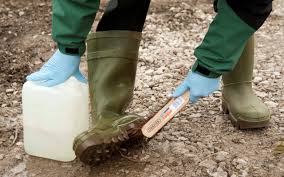Biosecurity in agriculture refers to the set of practices and measures implemented to protect farms and agricultural operations from the introduction and spread of diseases, pests, and other biological threats.
Effective biosecurity is crucial for maintaining animal health, crop health, and overall farm productivity. It involves preventing the entry of harmful organisms and managing risks to ensure a safe and healthy agricultural environment.
Importance of Biosecurity in Farming
1. Prevents Disease Outbreaks: Biosecurity measures help prevent the introduction of infectious diseases that can devastate animal populations or crops. By controlling the spread of diseases, farmers can avoid significant economic losses and protect their livelihoods.
2. Protects Animal and Crop Health: Ensuring that animals and plants are free from diseases and pests is essential for maintaining their health and productivity. Biosecurity practices contribute to better overall health and yield in agricultural operations.
3. Safeguards Food Supply: By preventing the spread of diseases and pests, biosecurity helps ensure a stable and safe food supply. Healthy animals and crops contribute to food security and quality.
4. Reduces Economic Losses: Disease outbreaks can lead to substantial financial losses due to decreased productivity, increased treatment costs, and potential market restrictions. Effective biosecurity minimizes these risks and helps maintain economic stability.
5. Supports Sustainable Agriculture: Biosecurity practices contribute to the long-term sustainability of farming operations by promoting healthy ecosystems and reducing the need for chemical interventions.
Key Biosecurity Principles
1. Prevention: The primary goal of biosecurity is to prevent the introduction and spread of harmful organisms. This involves implementing measures to avoid contact with potential sources of disease or pests.
2. Surveillance: Regular monitoring and surveillance are essential for detecting and addressing potential threats early. Surveillance helps identify and manage risks before they become major issues.
3. Containment: In the event of a disease outbreak or pest infestation, containment measures are implemented to limit the spread. This includes isolating affected areas and controlling the movement of animals or crops.
4. Eradication: If a disease or pest is detected, efforts are made to eradicate it from the affected area. This may involve treatment, removal of infected individuals, or other control measures.
5. Hygiene: Maintaining high standards of hygiene is crucial for biosecurity. This includes cleaning and disinfecting equipment, facilities, and vehicles to prevent the spread of pathogens.
6. Education and Training: Providing education and training for farm workers and stakeholders ensures that everyone understands and follows biosecurity protocols. Proper training helps prevent human errors and reinforces the importance of biosecurity.
Common Biosecurity Measures

1. Access Control: Restrict access to farm facilities and animal areas to authorized personnel only. Use sign-in logs and provide protective clothing for visitors to prevent the introduction of diseases.
2. Sanitation and Hygiene: Implement rigorous cleaning and disinfection procedures for equipment, facilities, and vehicles. Regularly clean and sanitize feed and water containers to reduce the risk of contamination.
3. Quarantine and Isolation: Isolate new or sick animals and plants before introducing them to the main population. This helps prevent the spread of diseases and pests to healthy individuals.
4. Pest and Rodent Control: Implement measures to control pests and rodents, which can carry diseases and cause damage. Use traps, bait stations, and other control methods to manage pest populations.
5. Health Monitoring: Regularly monitor the health of animals and crops for signs of illness or pests. Conduct routine inspections and diagnostic tests to identify and address potential issues early.
6. Waste Management: Properly manage and dispose of waste, including manure, plant debris, and other organic materials. Use composting or other methods to safely handle waste and prevent the spread of pathogens.
7. Biosecurity Training: Provide training for farm workers on biosecurity practices, including proper hygiene, handling procedures, and emergency response protocols. Ensure that everyone is aware of and follows biosecurity measures.
8. Record-Keeping: Maintain detailed records of biosecurity practices, including cleaning schedules, health monitoring, and any incidents. Accurate documentation helps track biosecurity efforts and identify areas for improvement.
Implementing Biosecurity Practices on the Farm
Implementing effective biosecurity practices is essential for safeguarding farm health and productivity. Here’s a step-by-step guide to implementing biosecurity measures on your farm:
1. Assess Risks and Develop a Plan: Start by assessing the potential biosecurity risks specific to your farm. Develop a comprehensive biosecurity plan that outlines strategies for preventing and managing these risks. Include measures for disease prevention, pest control, and sanitation.
2. Restrict Access: Control who can enter your farm and animal areas. Use barriers, fences, or gates to limit access. Ensure that all visitors sign in and are provided with protective clothing, such as boots and coveralls, to reduce the risk of introducing contaminants.
3. Establish Hygiene Protocols: Implement strict hygiene practices. Regularly clean and disinfect equipment, facilities, and vehicles. Provide handwashing stations and disinfectant footbaths at entry points to prevent the spread of pathogens.
4. Implement Quarantine Procedures: Isolate new or sick animals and plants before introducing them to the main population. This helps prevent the spread of diseases and allows for monitoring of their health.
5. Control Pests and Rodents: Use traps, bait stations, and other control methods to manage pest and rodent populations. Regularly inspect your farm for signs of infestation and address any issues promptly.
6. Monitor Health Regularly: Conduct routine health checks on animals and crops. Monitor for signs of illness or pest infestations and address any issues as soon as they are detected.
7. Manage Waste Properly: Dispose of waste materials, including manure and plant debris, in a safe and environmentally friendly manner. Use composting or other waste management methods to minimize the risk of contamination.
8. Educate and Train Staff: Provide training for all farm workers on biosecurity practices. Ensure they understand the importance of following protocols and are equipped to implement them effectively.
9. Review and Update Procedures: Regularly review and update your biosecurity plan to reflect changes in farm operations or new information about disease risks. Make improvements based on feedback and observations.
Read Also: 15 Healing Powers of Scent Leaf (Ocimmum gratissimum)
Monitoring and Evaluating Biosecurity Measures

Effective monitoring and evaluation are crucial for ensuring that biosecurity measures are working as intended and for making necessary adjustments. Here’s how to monitor and evaluate biosecurity measures on your farm:
1. Establish Monitoring Systems: Set up systems to track and monitor biosecurity practices. This can include regular inspections, health check records, and pest monitoring.
2. Conduct Regular Audits: Perform periodic audits of biosecurity practices to assess their effectiveness. Evaluate compliance with protocols and identify any areas for improvement.
3. Review Health Data: Analyze health records and data to identify trends or patterns in disease occurrences. Use this information to assess the effectiveness of your biosecurity measures and make necessary adjustments.
4. Seek Feedback: Gather feedback from farm workers and other stakeholders on the implementation of biosecurity practices. Their input can provide valuable insights into the effectiveness of measures and any challenges encountered.
5. Update Procedures: Based on monitoring and evaluation results, update biosecurity procedures to address any issues or gaps. Implement improvements to enhance overall biosecurity on the farm.
6. Document Changes: Keep detailed records of any changes made to biosecurity practices and the reasons for those changes. This documentation helps track progress and ensures consistency in implementation.
Case Studies: Successful Biosecurity Strategies
1. Case Study: Avian Influenza Control in Poultry Farms (USA, 2015): In response to an avian influenza outbreak, poultry farms implemented strict biosecurity measures, including enhanced sanitation, restricted access, and comprehensive health monitoring. These measures successfully contained the outbreak and prevented its spread to other farms.
2. Case Study: Managing Foot-and-Mouth Disease in Cattle (UK, 2001): During a Foot-and-Mouth Disease outbreak, farmers implemented aggressive quarantine protocols, restricted animal movements, and increased surveillance. These strategies effectively contained the disease and limited its economic impact.
3. Case Study: Biosecurity in Organic Vegetable Farming (Netherlands, 2018): Organic vegetable farms adopted biosecurity practices such as rotating crops, using disease-resistant plant varieties, and implementing strict hygiene protocols. These measures helped reduce the incidence of crop diseases and pests, improving overall farm productivity.
Read Also: Causes of Diseases in Farm Animals and How to Prevent Disease OutBreak
Challenges in Biosecurity and Solutions

1. Challenge: Compliance Issues: Ensuring that all farm workers follow biosecurity protocols consistently can be difficult. Solution: Provide regular training and reminders about the importance of biosecurity. Use visual aids and signs to reinforce practices and conduct periodic audits to check compliance.
2. Challenge: Resource Limitations: Farms may face limitations in resources for implementing biosecurity measures, such as equipment and funding. Solution: Prioritize critical biosecurity practices and seek funding or support from agricultural organizations. Consider cost-effective measures, such as using natural pest control methods.
3. Challenge: Disease Detection: Early detection of diseases or pests can be challenging. Solution: Implement regular health monitoring and diagnostic testing. Use advanced technologies, such as electronic monitoring systems, to improve early detection and response.
4. Challenge: External Threats: Biosecurity can be compromised by external factors, such as wild animals or neighboring farms. Solution: Use physical barriers and fencing to limit access from wild animals. Collaborate with neighboring farms to share information and address shared risks.
5. Challenge: Maintaining Hygiene: Keeping facilities and equipment consistently clean can be demanding. Solution: Develop and follow a rigorous cleaning schedule. Use effective disinfectants and cleaning agents and train staff on proper hygiene practices.
Biosecurity is a fundamental aspect of modern agriculture, crucial for protecting farms from diseases, pests, and other biological threats. Implementing robust biosecurity measures helps prevent outbreaks, safeguard animal and crop health, and ensure a stable and safe food supply.
Understanding and applying key biosecurity principles, such as prevention, surveillance, containment, and hygiene are essential for maintaining farm health. By restricting access, establishing hygiene protocols, implementing quarantine procedures, and managing pests, farmers can significantly reduce the risk of disease and pest introduction.
Monitoring and evaluating biosecurity practices is equally important. Regular audits, health data reviews, and feedback collection help ensure that biosecurity measures are effective and up-to-date. Addressing challenges such as compliance issues, resource limitations, and disease detection with practical solutions further enhances biosecurity on the farm.
Successful case studies from various agricultural sectors illustrate the effectiveness of well-implemented biosecurity strategies. These examples provide valuable insights into best practices and demonstrate the benefits of proactive biosecurity management.
Overall, investing in biosecurity is a proactive approach that pays off in the long run. By prioritizing biosecurity, farmers not only protect their operations but also contribute to the broader goal of sustainable and resilient agriculture.
Read Also: Grocery Gang: Everything You Need to Know

